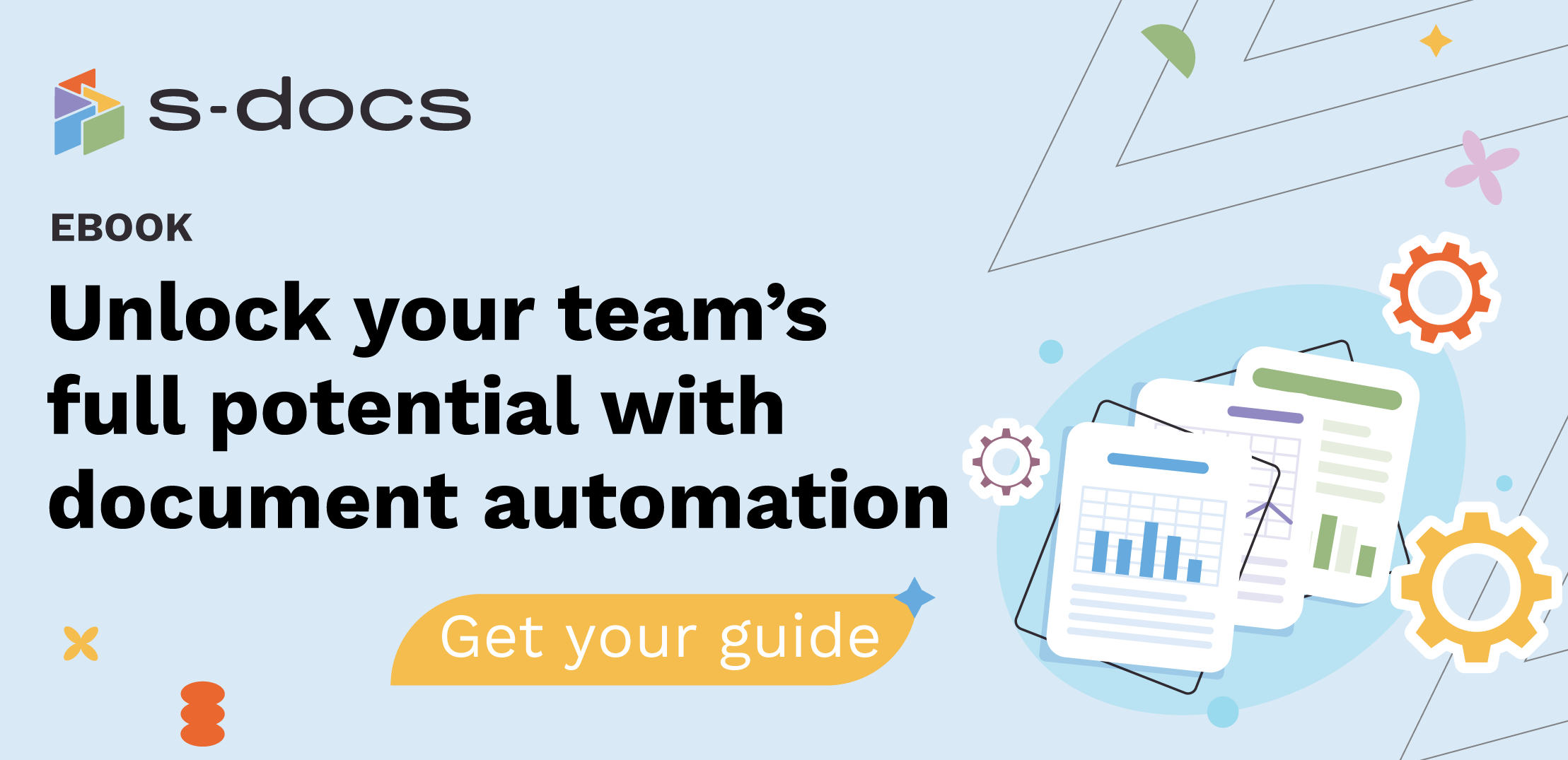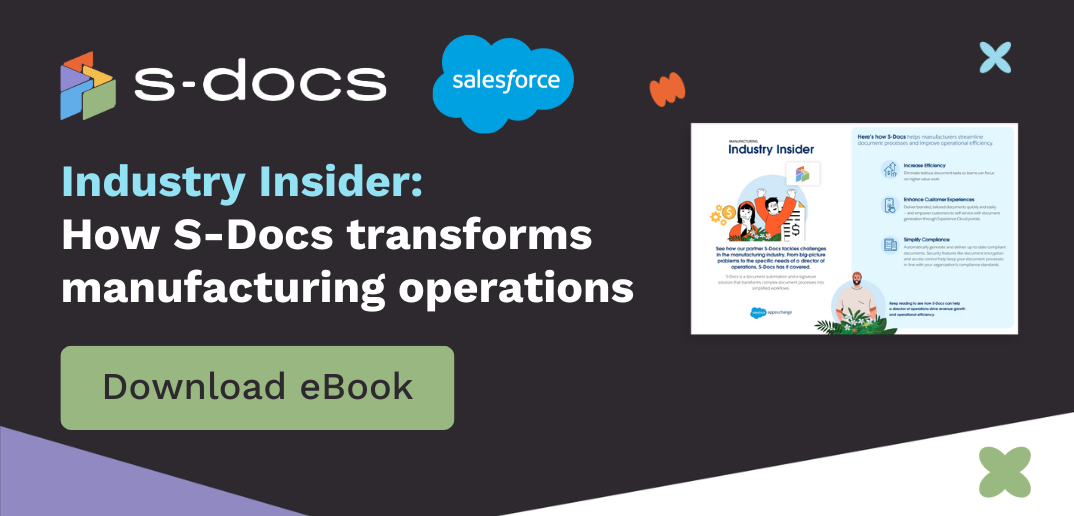Operational efficiency has become a key differentiator for organizations striving to stay ahead of the competition in an unpredictable business landscape. Yet operational excellence doesn’t just happen — you have to choose to put it into action.
In S-Docs’ recent virtual event, Operations Week 2023, we brought together operations experts from a variety of organizations to discuss building operational efficiency in our panel, “Becoming an Architect of Operational Efficiency.” The conversation delved into the importance of operational efficiency, where our operations gurus shared real-life tips and experiences and offered advice on implementing operational excellence at your workplace in 2024.
Read on for key takeaways from the panel discussion, moderated by Anand Narasimhan, CTO of S-Docs, and featuring Chris Fellure, founder of Mile High Dreamin’, Eric Dreshfield, founder of Midwest Dreamin’, and Gaurav Kheterpal, CEO of Vanshiv Technologies.
Defining and Measuring Operational Efficiency
The panel began by polling each member’s definition of operational efficiency. While everyone had a unique perspective, the consensus was that operational efficiency is the ability to effectively use organizational resources to achieve desired outcomes with minimum waste. Functionally, it involves streamlining processes, eliminating bottlenecks, and optimizing resource allocation.
Measuring operational efficiency is how your business identifies areas of improvement and tracks progress over time. As the saying goes, “What gets measured, gets managed.” Setting key performance indicators (KPIs) related to your organizational goals, such as cycle time, productivity, and customer satisfaction, can help assess operational efficiency and allow organizations to set realistic goals, track their progress towards achieving them, determine where they’re doing well, and where improvements are needed.
“Operations is what keeps the organization running on a day-to-day basis,” said Gaurav Kheterpal. “As far as measuring efficiency, there is no one-size-fits-all approach. The goal is just to be able to measure it, report on it, and pivot if needed.”
Challenges of Aligning Technical Processes with Organizational Goals
Aligning technical processes with organizational goals is easier said than done. Whether you’re an enterprise-level organization or a small startup, different stakeholders can have different priorities, making it difficult for everyone to solidify a direction. This conflict is made worse by communication gaps found in many organizations.
“How you communicate directly defines how you resolve your challenges,” said Gaurav Kheterpal.
You can address this issue by fostering a culture of open communication and collaboration. Easy to say, but hard to do, right? Yet opening up communication can be as simple as getting everyone together over coffee — or cocktails — and encouraging them to share their ideas.
“It's about leaders putting everyone in a safe space and saying there aren't any bad ideas,” says Chris Fellure. “Telling everyone, ‘We need to solve this, I’m not going to tell you what to do, but I want your input. Let's find the best path forward so we can build a solid foundation.’”
Companies that break down silos and promote cross-functional collaboration can bridge the gap between technical processes and organizational goals.
The Building Blocks of Operational Efficiency
Operational efficiency requires organizations to focus on a familiar framework: people, processes, and technology.
Building Block: People
People are the heart of any organization, so it’s no surprise they’re essential to operational efficiency. Your team must be willing to engage in conversations about what your organization’s goals are and how to reach them. You need to develop a culture of continuous improvement and be willing to challenge the status quo. When you empower employees to take ownership and contribute ideas for improvement, operational efficiency can be significantly enhanced.
It’s also important to be mindful of the holistic employee experience and ensure your team is enabled with the tools and knowledge required to do their jobs efficiently and gain satisfaction from their work. A happy team will always perform more effectively.
Building Block: Process
Efficiency also requires a good process. You can’t just throw tools at the end goal and hope you reach it. You have to establish how you’ll achieve your goals and empower users to own that process.
Building Block: Technology
Technology plays a pivotal role in designing and executing efficient processes and helps streamline operations, reduce manual errors, and improve overall operational efficiency. Though there isn’t one single technology that improves every situation, several discussed below are notable.
The Role of Technology in Designing Efficient Processes
At this point in the 21st century, technology will always be a part of business. More than 70% of senior leaders believe digital technology is essential to revenue, product development, customer engagement, and strategic operations.
The question is, what technology do you need, and what’s the best way to use it?
Automation
Companies use automation to eliminate manual, repetitive tasks and free up employees' time for more value-add activities. Automation has become so valuable that more than 50% of companies were estimated to incorporate its use in 2023.
Imagine you have a task that normally takes you two hours to complete. Can you use automation to complete it in 20 minutes instead? If you can, you’ll have the time to think about further strategic changes you can make throughout your organization.
P.S. If you’re ever curious about how much time you spend on paperwork, take our quiz to find out!
Data Analytics
You can analyze data to identify patterns, trends, and areas for improvement. For instance, analyzing customer data can help you identify customer preferences while tracking key performance indicators, enabling you to monitor progress toward achieving operational efficiency goals.
“Data should be the whole source of everything and where all the decisions come from,” said Eric Dreshfield. “Looking at the data that you have and analyzing the story that the data is really telling you will help drive the decision-making process.”
Collaboration Tools
Collaboration tools facilitate effective real-time communication and collaboration among team members across your organization. Collaboration tools have become essential with the rise of remote work and distributed teams, ensuring that everyone is on the same page and working towards common goals.
The tricky part of collaboration is to keep communication from becoming a distraction. The last thing you want is your employees saying, “This meeting could have been an email.”
Must-Have Technology Tools for Operations Teams
There’s no shortage of technology tools available to your operations teams, so you need to get specific about your needs and select the tools that align with your teams' goals. Here are some must-have technology tools for operations teams:
Customer Relationship Management (CRM) Software: CRM software like Salesforce helps you track customer interactions, store customer data, and analyze customer behavior. It provides your operations team with a holistic view of customer information and facilitates effective communication between sales, marketing, and customer service teams, ensuring a seamless customer journey.
Hyperautomation: Hyperautomation is using multiple tools, such as AI and robotic process automation (RPA) to speed up processes and remove humans from the loop where possible. This reduces errors and allows your employees to get more done in less time.
“Hyperautomation is when a machine completes a task more efficiently and with fewer errors than a human can,” said Gaurav Kheterpal. “That’s had a tremendous impact on the overall efficiency of organizations.”
Document Automation: Streamlining work with a document generation tool like S-Docs lets employees generate documents like contracts, non-disclosure agreements (NDAs), or other agreements quickly so they can spend time on their other more valuable duties, like selling or supporting sales.
Prioritizing Solutions for Your Team
With so many technology solutions available, choosing the right ones can be overwhelming. Start by identifying the pain points and areas of improvement within your organization to determine your goals. Analyze your existing processes and workflows, and get your team members’ input in the decision-making process. Consider factors such as scalability, integration capabilities, ease of use, and cost, and prioritize solutions that address your team's most critical needs.
Balancing Technology and Collaboration
Building a culture of collaboration is essential for operational efficiency, and technology should enhance that collaboration rather than replace human interaction. Foster a collaborative environment and encourage your team members to actively participate in process mapping, problem-solving, and decision-making. By finding the right balance between technology and collaboration, you can unlock the full potential of operational efficiency.
Leadership in Change Management
Implementing operational efficiency initiatives often involves change management — supporting individuals and teams while implementing changes in the organization. Effective leaders often practice a form of servant leadership, where managers empower team members to perform at their best.
An example of this is when a company needs buy-in from employees on a new technology. Employees may be resistant to adopting a new program like Salesforce because they’ve been using Excel spreadsheets for years. Companies can overcome resistance by designating a champion high up in the organization to use the preferred tool. When employees see managers embracing technology, they’re more likely to adopt it themselves.
Another example of effective change management leadership is to provide employees with the resources they need to effectively use the tools they have. That might mean after implementing a software tool like S-Docs for document creation, management provides training and the time needed to learn how to use the tool to its full potential.
The Future of Operational Efficiency in 2024
Heading into 2024, operational efficiency will continue to be a critical factor for companies that want to have their best year yet. There are many pieces to the operations puzzle. However, you can start by focusing on data, technology, and leadership.
If you need more ideas, S-Docs had a remarkable lineup of speakers during 2023’s Operations Week, from keynote addresses to panel discussions featuring real-world success stories. For more inspiring insights on how to harness operational efficiency, click here to watch this panel discussion, “Becoming an Architect of Operational Efficiency” and the rest of the Operations Week content.
Request a free demo today!







